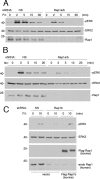Protein Kinase A-independent Ras Protein Activation Cooperates with Rap1 Protein to Mediate Activation of the Extracellular Signal-regulated Kinases (ERK) by cAMP
- PMID: 27531745
- PMCID: PMC5076829
- DOI: 10.1074/jbc.M116.730978
Protein Kinase A-independent Ras Protein Activation Cooperates with Rap1 Protein to Mediate Activation of the Extracellular Signal-regulated Kinases (ERK) by cAMP
Abstract
Cyclic adenosine monophosphate (cAMP) is an important mediator of hormonal stimulation of cell growth and differentiation through its activation of the extracellular signal-regulated kinase (ERK) cascade. Two small G proteins, Ras and Rap1, have been proposed to mediate this activation, with either Ras or Rap1 acting in distinct cell types. Using Hek293 cells, we show that both Ras and Rap1 are required for cAMP signaling to ERKs. The roles of Ras and Rap1 were distinguished by their mechanism of activation, dependence on the cAMP-dependent protein kinase (PKA), and the magnitude and kinetics of their effects on ERKs. Ras was required for the early portion of ERK activation by cAMP and was activated independently of PKA. Ras activation required the Ras/Rap guanine nucleotide exchange factor (GEF) PDZ-GEF1. Importantly, this action of PDZ-GEF1 was disrupted by mutation within its putative cyclic nucleotide-binding domain within PDZ-GEF1. Compared with Ras, Rap1 activation of ERKs was of longer duration. Rap1 activation was dependent on PKA and required Src family kinases and the Rap1 exchanger C3G. This is the first report of a mechanism for the cooperative actions of Ras and Rap1 in cAMP activation of ERKs. One physiological role for the sustained activation of ERKs is the transcription and stabilization of a range of transcription factors, including c-FOS. We show that the induction of c-FOS by cAMP required both the early and sustained phases of ERK activation, requiring Ras and Rap1, as well as for each of the Raf isoforms, B-Raf and C-Raf.
Keywords: Ras protein; Ras-related protein 1 (Rap1); cyclic AMP (cAMP); extracellular-signal-regulated kinase (ERK); guanine nucleotide exchange factor (GEF).
© 2016 by The American Society for Biochemistry and Molecular Biology, Inc.
Figures










Similar articles
-
Phosphorylation of Rap1 by cAMP-dependent Protein Kinase (PKA) Creates a Binding Site for KSR to Sustain ERK Activation by cAMP.J Biol Chem. 2017 Jan 27;292(4):1449-1461. doi: 10.1074/jbc.M116.768986. Epub 2016 Dec 21. J Biol Chem. 2017. PMID: 28003362 Free PMC article.
-
Rap1-mediated activation of extracellular signal-regulated kinases by cyclic AMP is dependent on the mode of Rap1 activation.Mol Cell Biol. 2006 Mar;26(6):2130-45. doi: 10.1128/MCB.26.6.2130-2145.2006. Mol Cell Biol. 2006. PMID: 16507992 Free PMC article.
-
Ras-mutant cancer cells display B-Raf binding to Ras that activates extracellular signal-regulated kinase and is inhibited by protein kinase A phosphorylation.J Biol Chem. 2013 Sep 20;288(38):27646-27657. doi: 10.1074/jbc.M113.463067. Epub 2013 Jul 26. J Biol Chem. 2013. PMID: 23893412 Free PMC article.
-
Crosstalk between cAMP and MAP kinase signaling in the regulation of cell proliferation.Trends Cell Biol. 2002 Jun;12(6):258-66. doi: 10.1016/s0962-8924(02)02294-8. Trends Cell Biol. 2002. PMID: 12074885 Review.
-
Regulation of PC12 cell differentiation by cAMP signaling to ERK independent of PKA: do all the connections add up?Sci STKE. 2007 Apr 17;2007(382):pe15. doi: 10.1126/stke.3822007pe15. Sci STKE. 2007. PMID: 17440132 Free PMC article. Review.
Cited by
-
Structural Analysis of Hippocampal Kinase Signal Transduction.ACS Chem Neurosci. 2018 Dec 19;9(12):3072-3085. doi: 10.1021/acschemneuro.8b00284. Epub 2018 Aug 13. ACS Chem Neurosci. 2018. PMID: 30053369 Free PMC article.
-
β2-Adrenoceptor Activation Stimulates IL-6 Production via PKA, ERK1/2, Src, and Beta-Arrestin2 Signaling Pathways in Human Bronchial Epithelia.Lung. 2021 Dec;199(6):619-627. doi: 10.1007/s00408-021-00484-0. Epub 2021 Nov 1. Lung. 2021. PMID: 34725715 Free PMC article.
-
The road to ERK activation: Do neurons take alternate routes?Cell Signal. 2020 Apr;68:109541. doi: 10.1016/j.cellsig.2020.109541. Epub 2020 Jan 13. Cell Signal. 2020. PMID: 31945453 Free PMC article. Review.
-
cAMP Signaling in Cancer: A PKA-CREB and EPAC-Centric Approach.Cells. 2022 Jun 24;11(13):2020. doi: 10.3390/cells11132020. Cells. 2022. PMID: 35805104 Free PMC article. Review.
-
Protein kinase A and local signaling in cancer.Biochem J. 2024 Nov 20;481(22):1659-1677. doi: 10.1042/BCJ20230352. Biochem J. 2024. PMID: 39540434 Free PMC article. Review.
References
-
- Gomez E., Pritchard C., and Herbert T. P. (2002) cAMP-dependent protein kinase and Ca2+ influx through L-type voltage-gated calcium channels mediate Raf-independent activation of extracellular regulated kinase in response to glucagon-like peptide-1 in pancreatic beta-cells. J. Biol. Chem. 277, 48146–48151 - PubMed
-
- Ehses J. A., Pelech S. L., Pederson R. A., and McIntosh C. H. (2002) Glucose-dependent insulinotropic polypeptide activates the Raf-Mek1/2-ERK1/2 module via a cyclic AMP/cAMP-dependent protein kinase/Rap1-mediated pathway. J. Biol. Chem. 277, 37088–37097 - PubMed
-
- Fujita T., Meguro T., Fukuyama R., Nakamuta H., and Koida M. (2002) New signaling pathway for parathyroid hormone and cyclic AMP action on extracellular-regulated kinase and cell proliferation in bone cells. Checkpoint of modulation by cyclic AMP. J. Biol. Chem. 277, 22191–22200 - PubMed
-
- Van Kolen K., Dautzenberg F. M., Verstraeten K., Royaux I., De Hoogt R., Gutknecht E., and Peeters P. J. (2010) Corticotropin releasing factor-induced ERK phosphorylation in AtT20 cells occurs via a cAMP-dependent mechanism requiring EPAC2. Neuropharmacology 58, 135–144 - PubMed
-
- Le Péchon-Vallée C., Magalon K., Rasolonjanahary R., Enjalbert A., and Gérard C. (2000) Vasoactive intestinal polypeptide and pituitary adenylate cyclase-activating polypeptides stimulate mitogen-activated protein kinase in the pituitary cell line GH4C1 by a 3′,5′-cyclic adenosine monophosphate pathway. Neuroendocrinology 72, 46–56 - PubMed
MeSH terms
Substances
Grants and funding
LinkOut - more resources
Full Text Sources
Other Literature Sources
Molecular Biology Databases
Research Materials
Miscellaneous

